Effect of Production Bias on Radiation-Induced Segregation in Ni-Cr Alloys
Abstract
:1. Introduction
2. Methodology
3. Results and Discussion
3.1. Surface-Mediated Patterns and Size Anomalies
3.2. Effect of Dose Rate
3.3. The Combined Effect of Dose Rate, Production Bias, and Size on RIS in Ni-Cr
3.4. Effect of Temperature
3.5. Investigating the Interplay between Temperature, Size, and Production Bias on RIS in Ni-Cr
3.6. Effect of Sink Density
3.7. Effect of the Sink Efficiency of the Surface
3.8. Comparison with Experiments
4. Concluding Remarks
Author Contributions
Funding
Institutional Review Board Statement
Informed Consent Statement
Data Availability Statement
Conflicts of Interest
References
- International Energy Forum. Huge Divergence Persists in Long Term Energy Outlooks—IEF Report. In Proceedings of the 13th IEA-IEF-OPEC Symposium on Energy Outlooks, Riyadh, Saudi Arabia, 15 February 2023. [Google Scholar]
- Zinkle, S.; Was, G. Materials challenges in nuclear energy. Acta Mater. 2013, 61, 735–758. [Google Scholar] [CrossRef]
- Was, G.S. Fundamentals of Radiation Materials Science; Springer: New York, NY, USA, 2017. [Google Scholar] [CrossRef]
- Marquis, E.A.; Hu, R.; Rousseau, T. A systematic approach for the study of radiation-induced segregation/depletion at grain boundaries in steels. J. Nucl. Mater. 2011, 413, 1–4. [Google Scholar] [CrossRef]
- Bruemmer, S.; Simonen, E.; Scott, P.; Andresen, P.; Was, G.; Nelson, J. Radiation-induced material changes and susceptibility to intergranular failure of light-water-reactor core internals. J. Nucl. Mater. 1999, 274, 299–314. [Google Scholar] [CrossRef]
- Tucker, J.; Najafabadi, R.; Allen, T.; Morgan, D. Ab initio-based diffusion theory and tracer diffusion in Ni–Cr and Ni–Fe alloys. J. Nucl. Mater. 2010, 405, 216–234. [Google Scholar] [CrossRef]
- Singh, B.N. Effect of grain size on void formation during high-energy electron irradiation of austenitic stainless steel. Philos. Mag. J. Theor. Exp. Appl. Phys. 1974, 29, 25–42. [Google Scholar] [CrossRef]
- Watanabe, S.; Takamatsu, Y.; Sakaguchi, N.; Takahashi, H. Sink effect of grain boundary on radiation-induced segregation in austenitic stainless steel. J. Nucl. Mater. 2000, 283–287, 152–156. [Google Scholar] [CrossRef]
- Zinkle, S.; Maziasz, P.; Stoller, R. Dose dependence of the microstructural evolution in neutron-irradiated austenitic stainless steel. J. Nucl. Mater. 1993, 206, 266–286. [Google Scholar] [CrossRef]
- Robinson, T.M.; Jenkins, M.L. Heavy-ion irradiation of nickel and nickel alloys. Philos. Mag. A 1981, 43, 999–1015. [Google Scholar] [CrossRef]
- Garner, F.A. Swelling of Neutron-Irradiated 85Ni-15Cr at 400 to 650/sup 0/C; Technical Report; ResearchGate: Berlin, Germany, 1984. [Google Scholar]
- Barr, C.M.; Barnard, L.; Nathaniel, J.E.; Hattar, K.; Unocic, K.A.; Szlurfarska, I.; Morgan, D.; Taheri, M.L. Grain boundary character dependence of radiation-induced segregation in a model Ni–Cr alloy. J. Mater. Res. 2015, 30, 1290–1299. [Google Scholar] [CrossRef]
- Briggs, S.A.; Barr, C.M.; Pakarinen, J.; Mamivand, M.; Hattar, K.; Morgan, D.D.; Taheri, M.; Sridharan, K. Observations of defect structure evolution in proton and Ni ion irradiated Ni-Cr binary alloys. J. Nucl. Mater. 2016, 479, 48–58. [Google Scholar] [CrossRef]
- Barr, C.M.; Felfer, P.J.; Cole, J.I.; Taheri, M.L. Observation of oscillatory radiation induced segregation profiles at grain boundaries in neutron irradiated 316 stainless steel using atom probe tomography. J. Nucl. Mater. 2018, 504, 181–190. [Google Scholar] [CrossRef]
- Hu, S.; Li, Y.; Burkes, D.; Senor, D.J. Microstructure-Dependent Rate Theory Model of Radiation-Induced Segregation in Binary Alloys. Front. Mater. 2021, 8, 682686. [Google Scholar] [CrossRef]
- Thuinet, L.; Nastar, M.; Martinez, E.; Bouobda Moladje, G.; Legris, A.; Soisson, F. Multiscale modeling of Radiation Induced Segregation in iron based alloys. Comput. Mater. Sci. 2018, 149, 324–335. [Google Scholar] [CrossRef]
- Barnard, L.; Tucker, J.; Choudhury, S.; Allen, T.; Morgan, D. Modeling radiation induced segregation in Ni–Cr model alloys from first principles. J. Nucl. Mater. 2012, 425, 8–15. [Google Scholar] [CrossRef]
- Wharry, J.P.; Jiao, Z.; Was, G.S. Application of the inverse Kirkendall model of radiation-induced segregation to ferritic–martensitic alloys. J. Nucl. Mater. 2012, 425, 117–124. [Google Scholar] [CrossRef]
- Field, K.G.; Barnard, L.M.; Parish, C.M.; Busby, J.T.; Morgan, D.; Allen, T.R. Dependence on grain boundary structure of radiation induced segregation in a 9wt.% Cr model ferritic/martensitic steel. J. Nucl. Mater. 2013, 435, 172–180. [Google Scholar] [CrossRef]
- Woo, C.; Semenov, A.; Singh, B. Analysis of microstructural evolution driven by production bias. J. Nucl. Mater. 1993, 206, 170–199. [Google Scholar] [CrossRef]
- Dudarev, S.L.; Semenov, A.A.; Woo, C.H. Heterogeneous void swelling near grain boundaries in irradiated materials. Phys. Rev. B 2003, 67, 094103. [Google Scholar] [CrossRef]
- Ozturk, A.; Gencturk, M.; Ahmed, K. Surface and Size Effects on the Behaviors of Point Defects in Irradiated Crystalline Solids. Front. Mater. 2021, 8, 684862. [Google Scholar] [CrossRef]
- Wiedersich, H.; Okamoto, P.; Lam, N. A theory of radiation-induced segregation in concentrated alloys. J. Nucl. Mater. 1979, 83, 98–108. [Google Scholar] [CrossRef]
- Ma, K.; Décamps, B.; Fraczkiewicz, A.; Jourdan, T.; Prima, F.; Loyer-Prost, M. Free surface impact on radiation damage in pure nickel by in-situ self-ion irradiation: Can it be avoided? Acta Mater. 2021, 212, 116874. [Google Scholar] [CrossRef]
- Field, K.G.; Briggs, S.A.; Hu, X.; Yamamoto, Y.; Howard, R.H.; Sridharan, K. Heterogeneous dislocation loop formation near grain boundaries in a neutron-irradiated commercial FeCrAl alloy. J. Nucl. Mater. 2017, 483, 54–61. [Google Scholar] [CrossRef]
- Mao, P.; Cui, J.; Chen, Y.; Qiu, J.; Jin, Q.; Qiao, J.; Zhao, Y.; Cui, K.; Gao, N.; Tai, K. Quantitative investigation on sink strength of nano-grain boundary for irradiation resistance. J. Nucl. Mater. 2019, 526, 151741. [Google Scholar] [CrossRef]
- Demkowicz, M.J.; Hoagland, R.G.; Uberuaga, B.P.; Misra, A. Influence of interface sink strength on the reduction of radiation-induced defect concentrations and fluxes in materials with large interface area per unit volume. Phys. Rev. B 2011, 84, 104102. [Google Scholar] [CrossRef]
- Yang, Y.; Huang, H.; Zinkle, S.J. Anomaly in dependence of radiation-induced vacancy accumulation on grain size. J. Nucl. Mater. 2010, 405, 261–265. [Google Scholar] [CrossRef]
- Allen, T.; Tan, L.; Was, G.; Kenik, E. Thermal and radiation-induced segregation in model Ni-base alloys. J. Nucl. Mater. 2007, 361, 174–183. [Google Scholar] [CrossRef]
- Martin, G.; Sabathier, C.; Wiktor, J.; Maillard, S. Molecular dynamics study of the bulk temperature effect on primary radiation damage in uranium dioxide. Nucl. Instrum. Methods Phys. Res. Sect. B Beam Interact. Mater. Atoms 2015, 352, 135–139. [Google Scholar] [CrossRef]
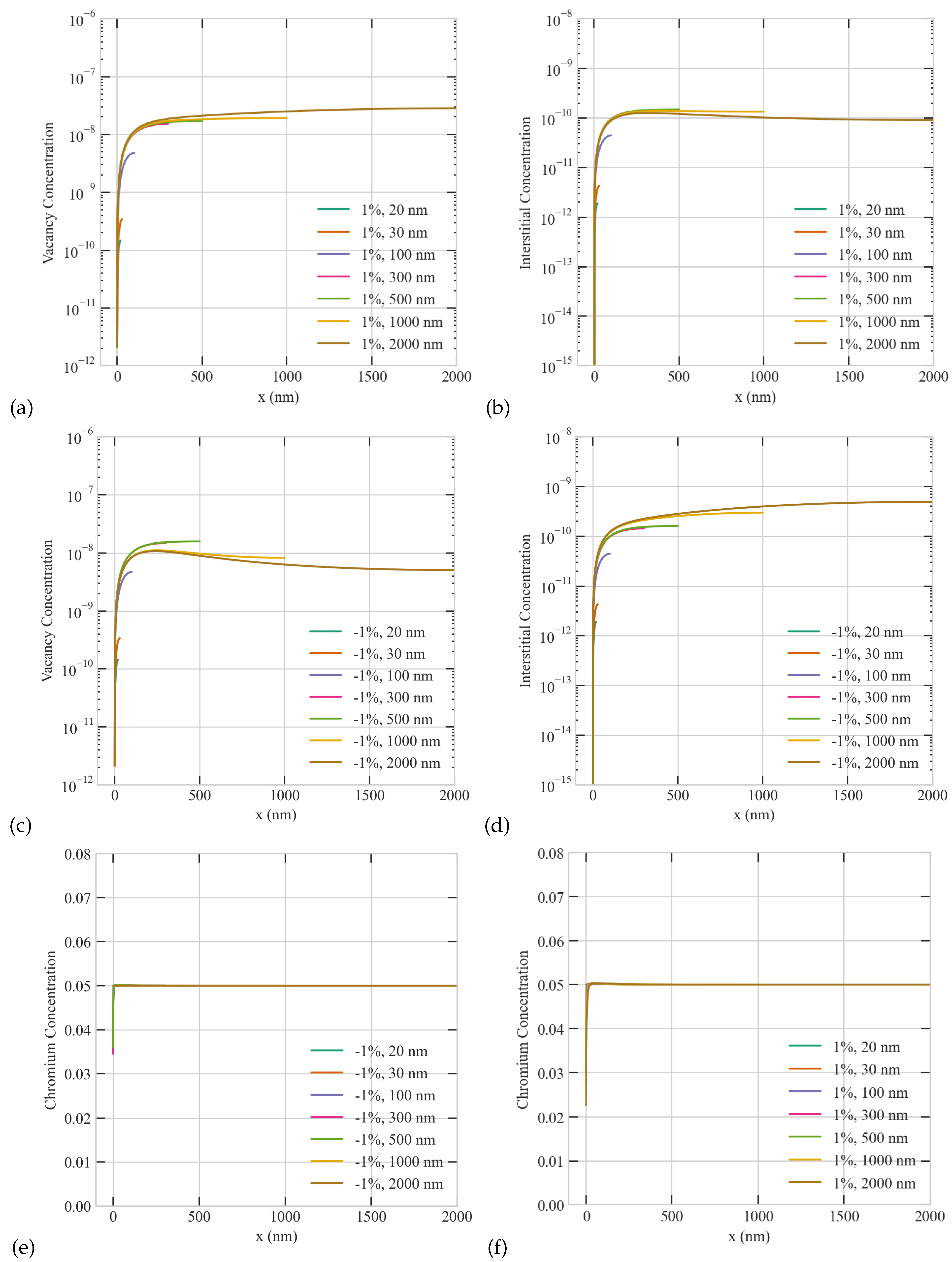



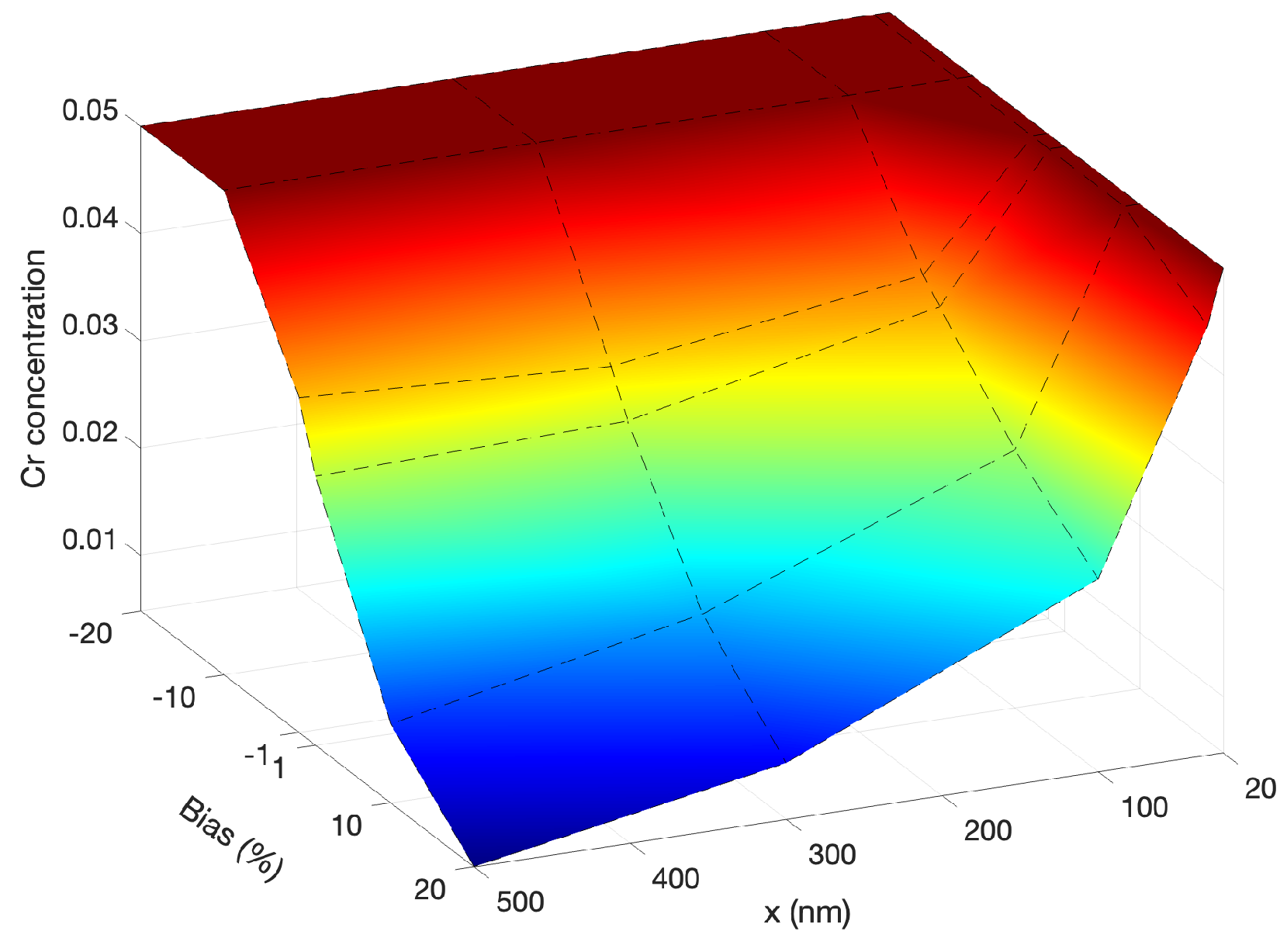
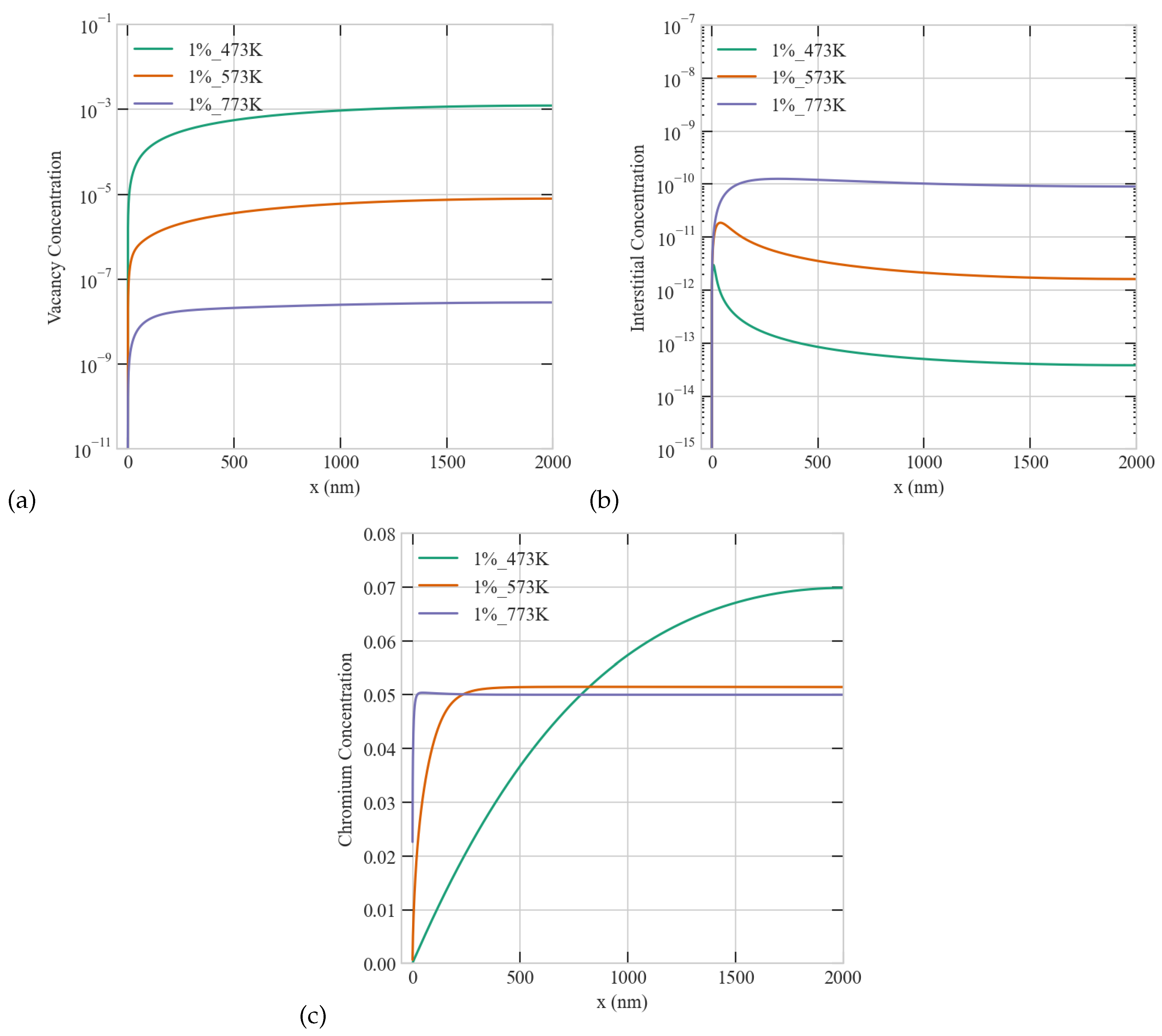
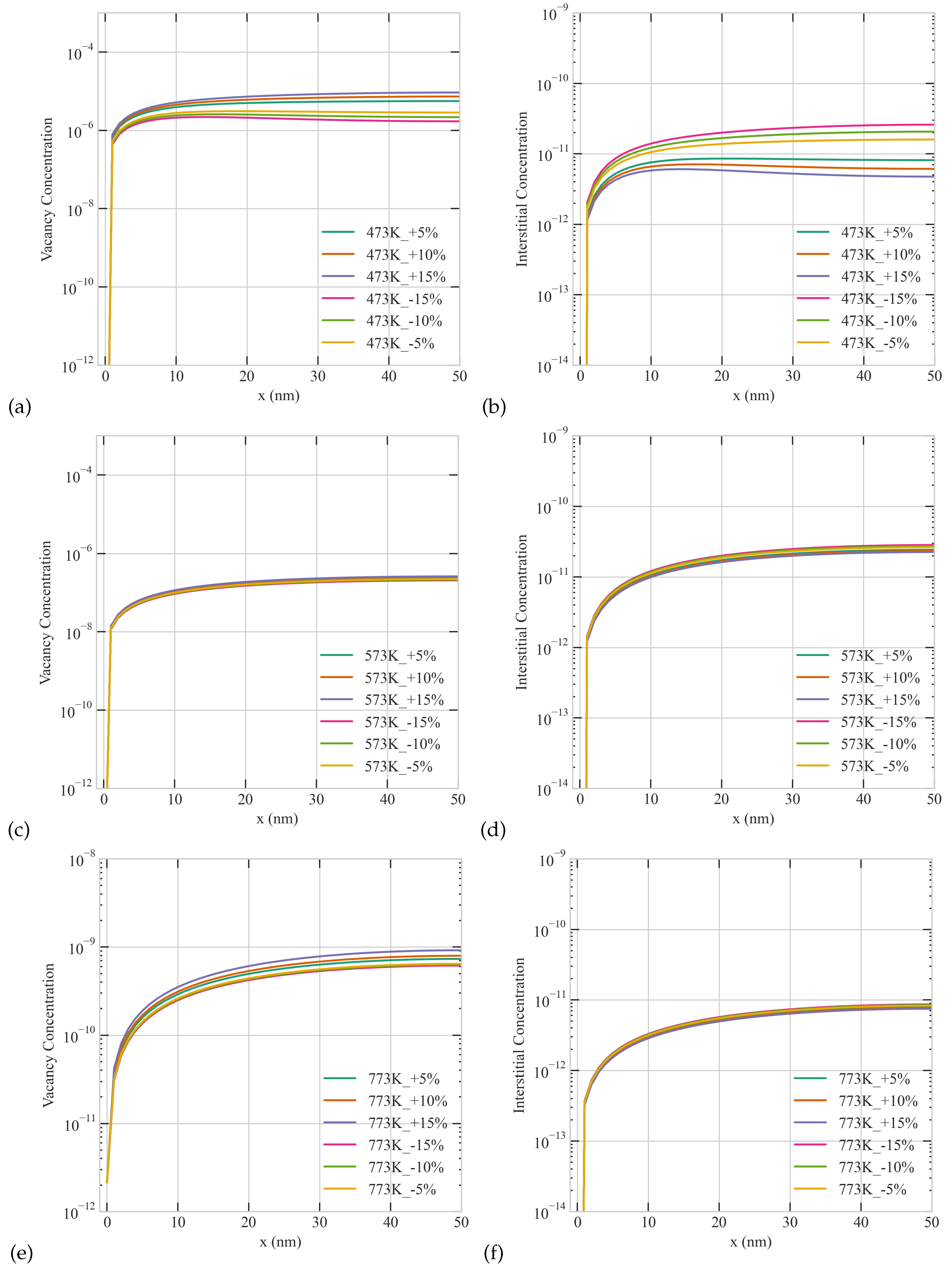

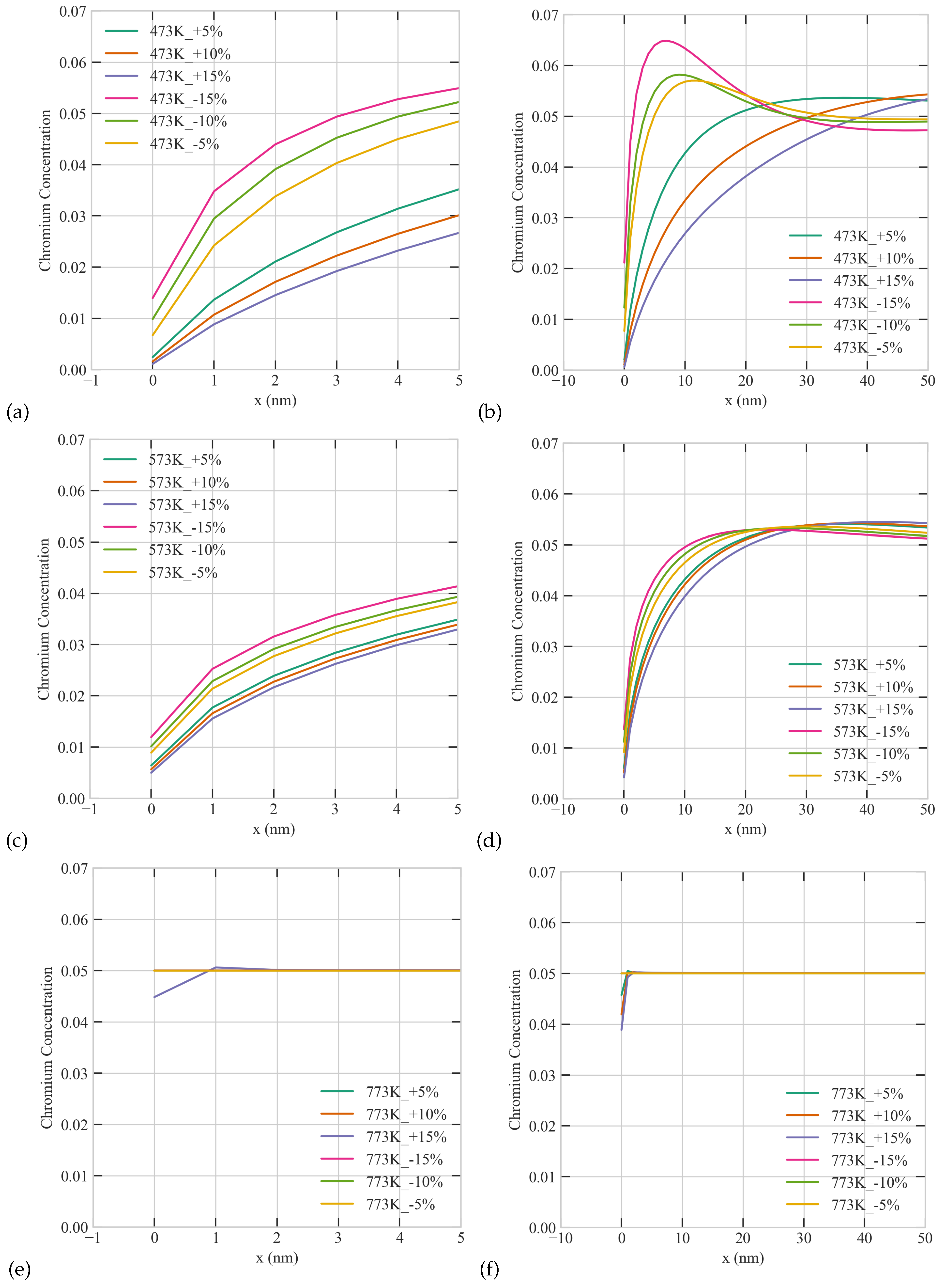
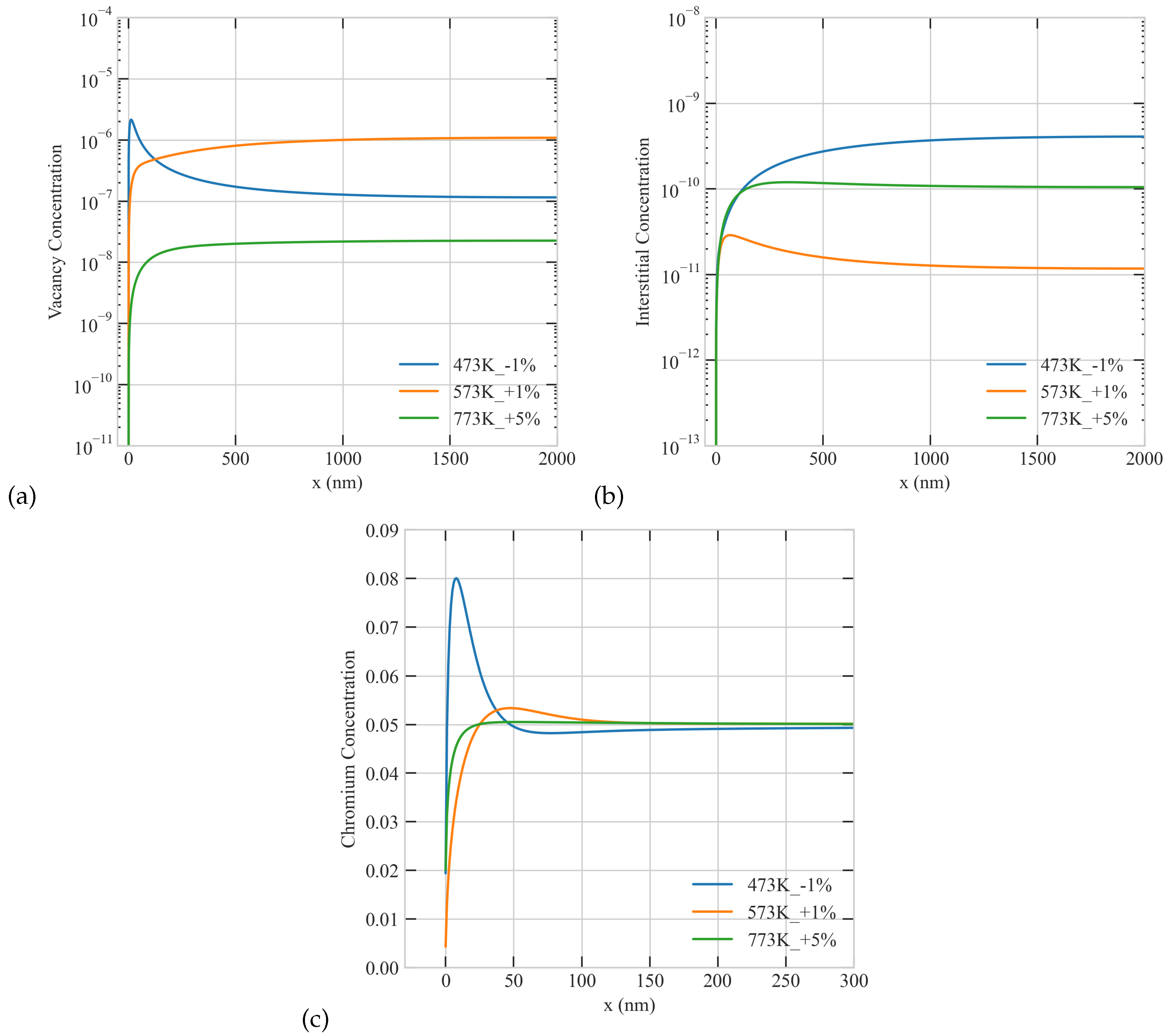


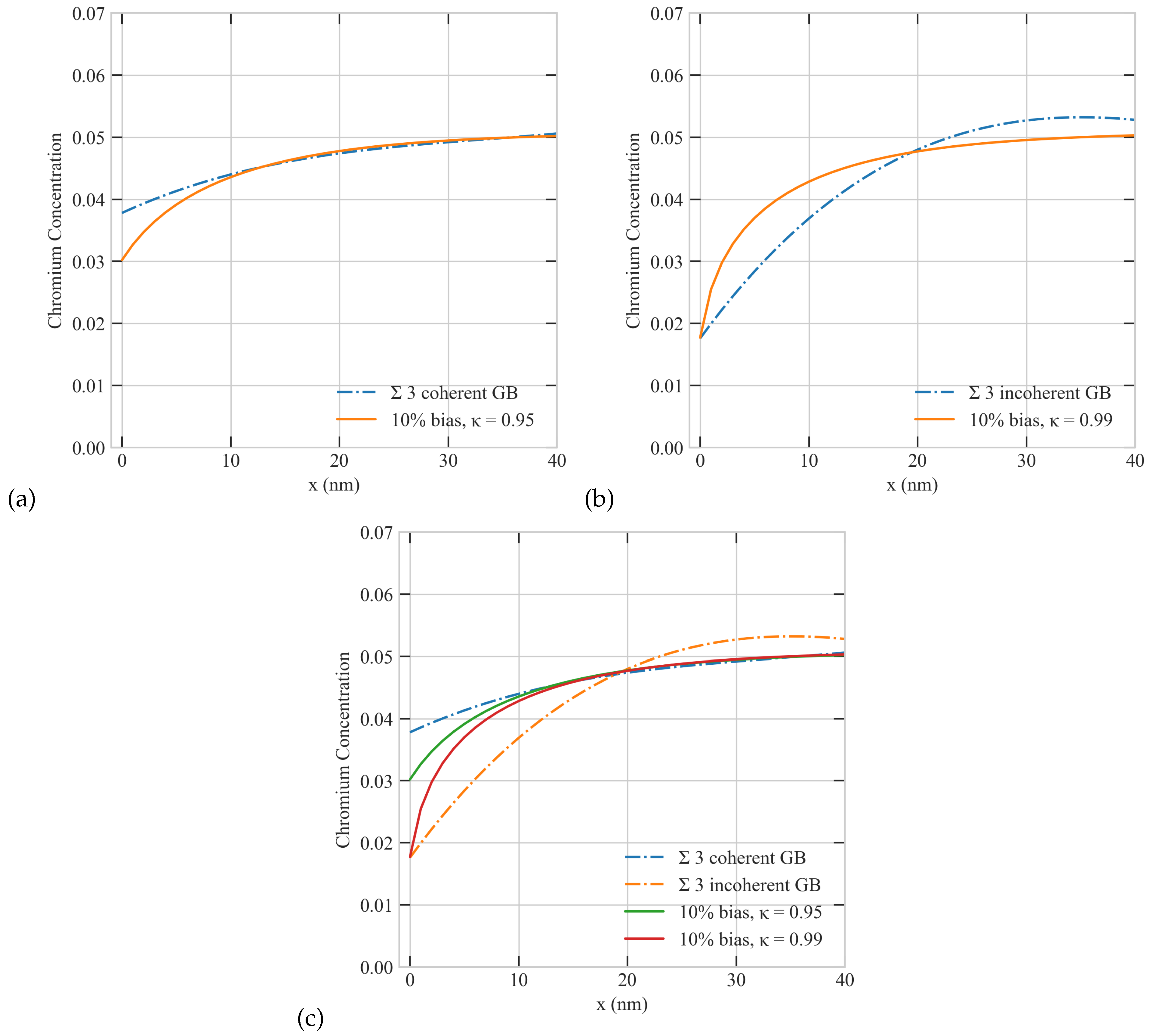
| Parameter | Value |
|---|---|
| Pre-exponential factor for Ni interstitial diffusivity | 5.04 m/s |
| Pre-exponential factor for Cr interstitial diffusivity | 3.20 m/s |
| Pre-exponential factor for Ni vacancy diffusivity | 1.85 m/s |
| Pre-exponential factor for Cr vacancy diffusivity | 2.26 m/s |
| Activation energy for Ni interstitial diffusivity | 0.30 eV |
| Activation energy for Cr interstitial diffusivity | 0.37 eV |
| Activation energy for Ni vacancy diffusivity | 1.16 eV |
| Activation energy for Cr vacancy diffusivity | 1.10 eV |
| Vacancy formation energy | 1.79 eV |
| Interstitial formation energy | 4.0 eV |
Disclaimer/Publisher’s Note: The statements, opinions and data contained in all publications are solely those of the individual author(s) and contributor(s) and not of MDPI and/or the editor(s). MDPI and/or the editor(s) disclaim responsibility for any injury to people or property resulting from any ideas, methods, instructions or products referred to in the content. |
© 2023 by the authors. Licensee MDPI, Basel, Switzerland. This article is an open access article distributed under the terms and conditions of the Creative Commons Attribution (CC BY) license (https://creativecommons.org/licenses/by/4.0/).
Share and Cite
Gencturk, M.; Ozturk, A.; Ahmed, K. Effect of Production Bias on Radiation-Induced Segregation in Ni-Cr Alloys. Materials 2023, 16, 7475. https://doi.org/10.3390/ma16237475
Gencturk M, Ozturk A, Ahmed K. Effect of Production Bias on Radiation-Induced Segregation in Ni-Cr Alloys. Materials. 2023; 16(23):7475. https://doi.org/10.3390/ma16237475
Chicago/Turabian StyleGencturk, Merve, Abdurrahman Ozturk, and Karim Ahmed. 2023. "Effect of Production Bias on Radiation-Induced Segregation in Ni-Cr Alloys" Materials 16, no. 23: 7475. https://doi.org/10.3390/ma16237475
APA StyleGencturk, M., Ozturk, A., & Ahmed, K. (2023). Effect of Production Bias on Radiation-Induced Segregation in Ni-Cr Alloys. Materials, 16(23), 7475. https://doi.org/10.3390/ma16237475






